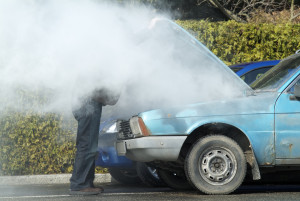
Although the weather is getting colder, this doesn’t mean that you’re off the hook when it comes to the overheating of your car. If you do not have a proper cooling system, it is still definitely possible for your car to overheat. Incorrect antifreeze/ coolant mixtures or a malfunctioning radiator or thermostat could all cause the car to overheat at any temperature. Therefore, it’s always important to get your car’s cooling system checked periodically to ensure everything is running smoothly.
But let’s say that you forgot or you have done it and there is an acute issue with the car that causes the car to overheat. What should you do if you start to see a warning light or worse: smoke coming from your engine? Here are several things to keep in mind to keep you and your passengers safe and protect your vehicle:
Pull Off to the Side of the Road If Possible: Don’t disregard a warning light that indicates a high temperature. You’ll only do damage to your car if you try to maintain normal function, and you’ll lose visibility if the engine starts to smoke, endangering the lives of those in your vehicle and other motorists in your vicinity.
If You Cannot Pull Over, Put Your Car in Neutral and Rev the Engine at a Traffic Light: If there is no shoulder, you might not be able to pull over right away. By putting your car in neutral and revving the engine, you’ll allow more water and air flow through the radiator. If you’re in stop-and-go traffic, avoid using the brake as this will cause your car to overheat faster.
Do a Quick Diagnostics Check When You’re Safely Pulled Over: Hopefully you have coolant and water in your trunk. If your coolant levels are low or you notice a leak, topping it off with coolant or even water may do the trick. Remember that you’ll need a 50/50 mix of coolant and water, so if you only have water, you’ll need to add coolant as soon as you can. If your coolant levels are full, you might have an electrical or other engine issue that will require a tow and professional assistance. And we almost forgot: wait until the engine cools a bit before you perform any diagnostics.
Learn more tips about vehicle safety, registration tips, and other issues by visiting eTags.com blog here.